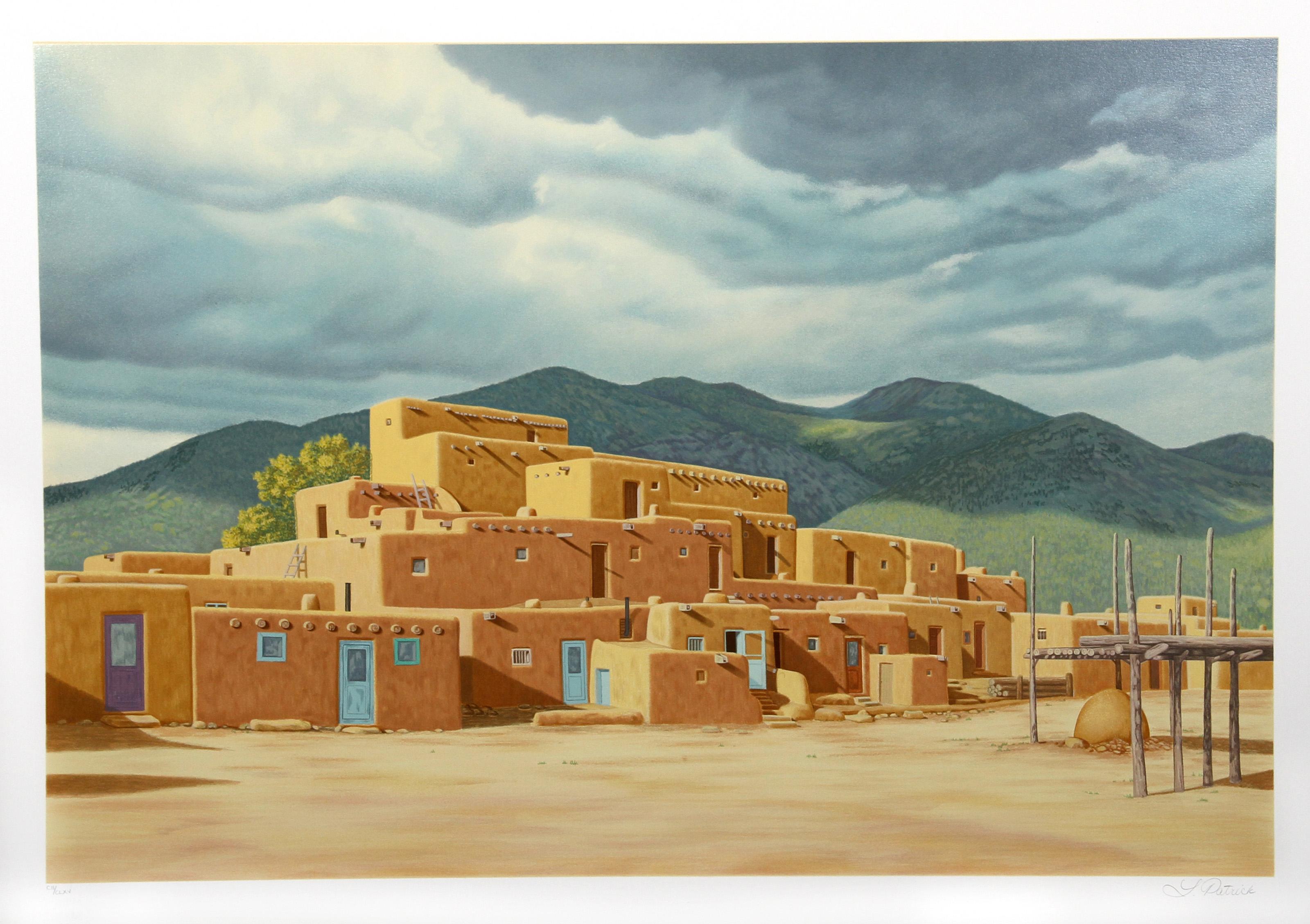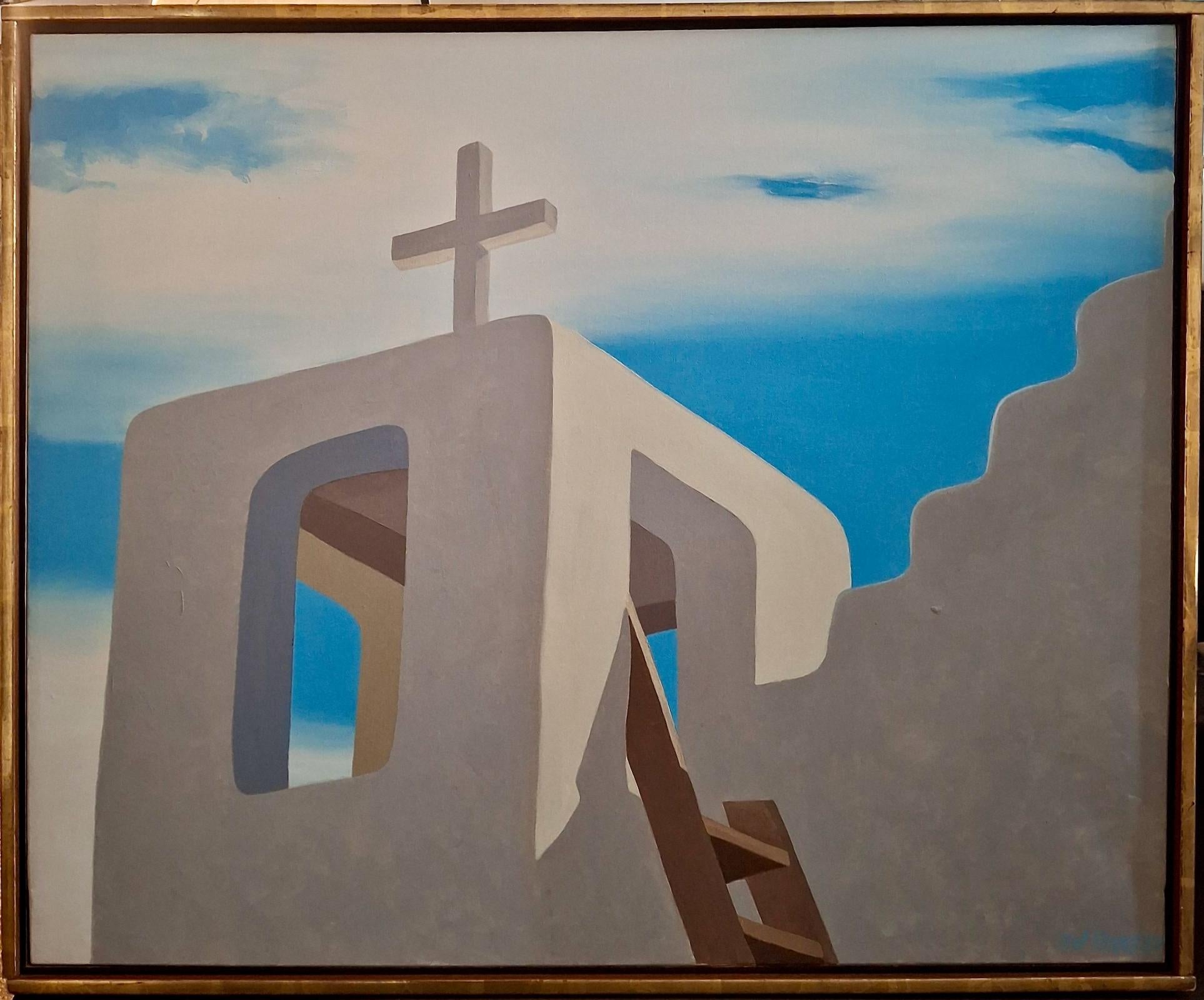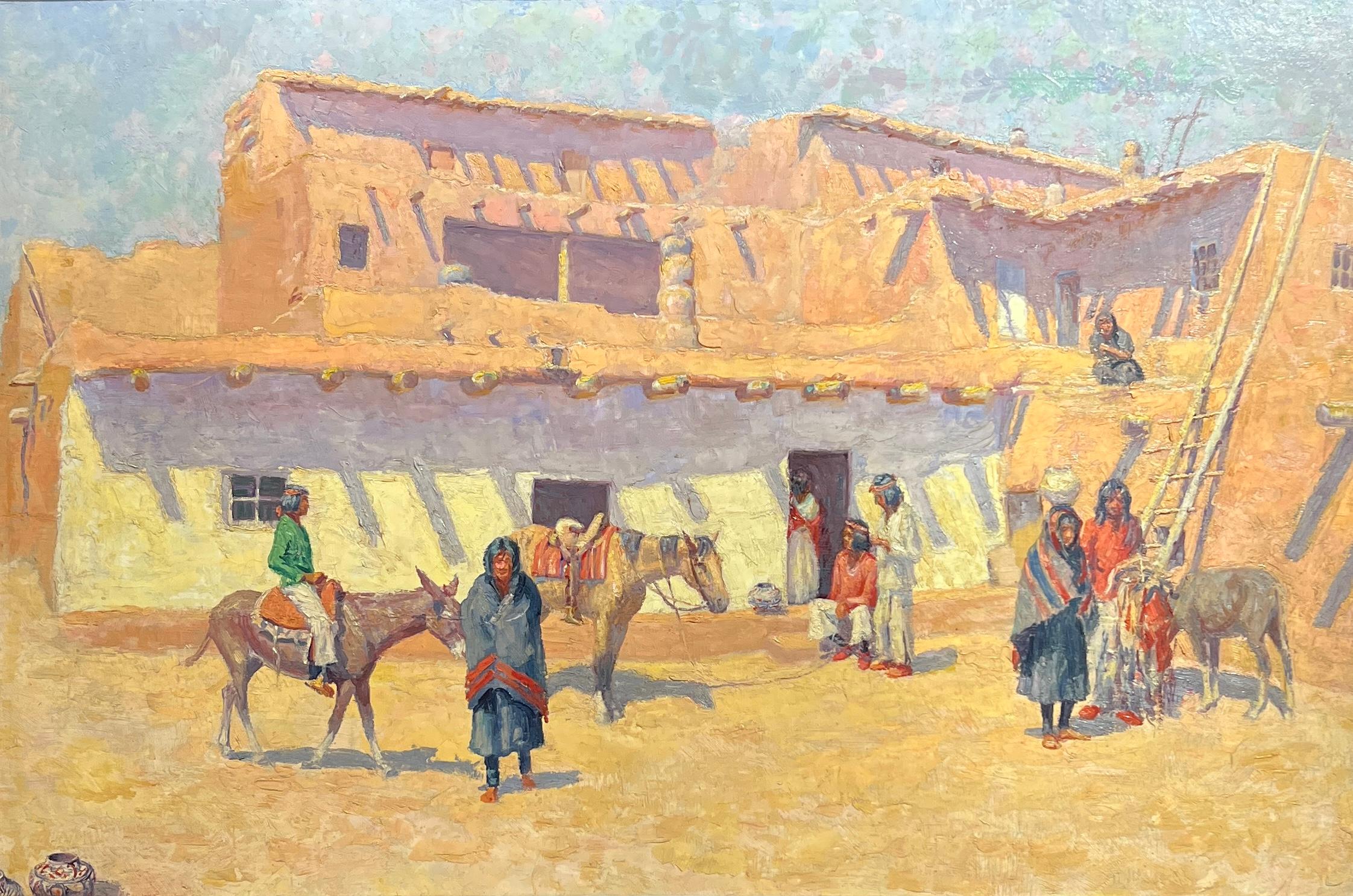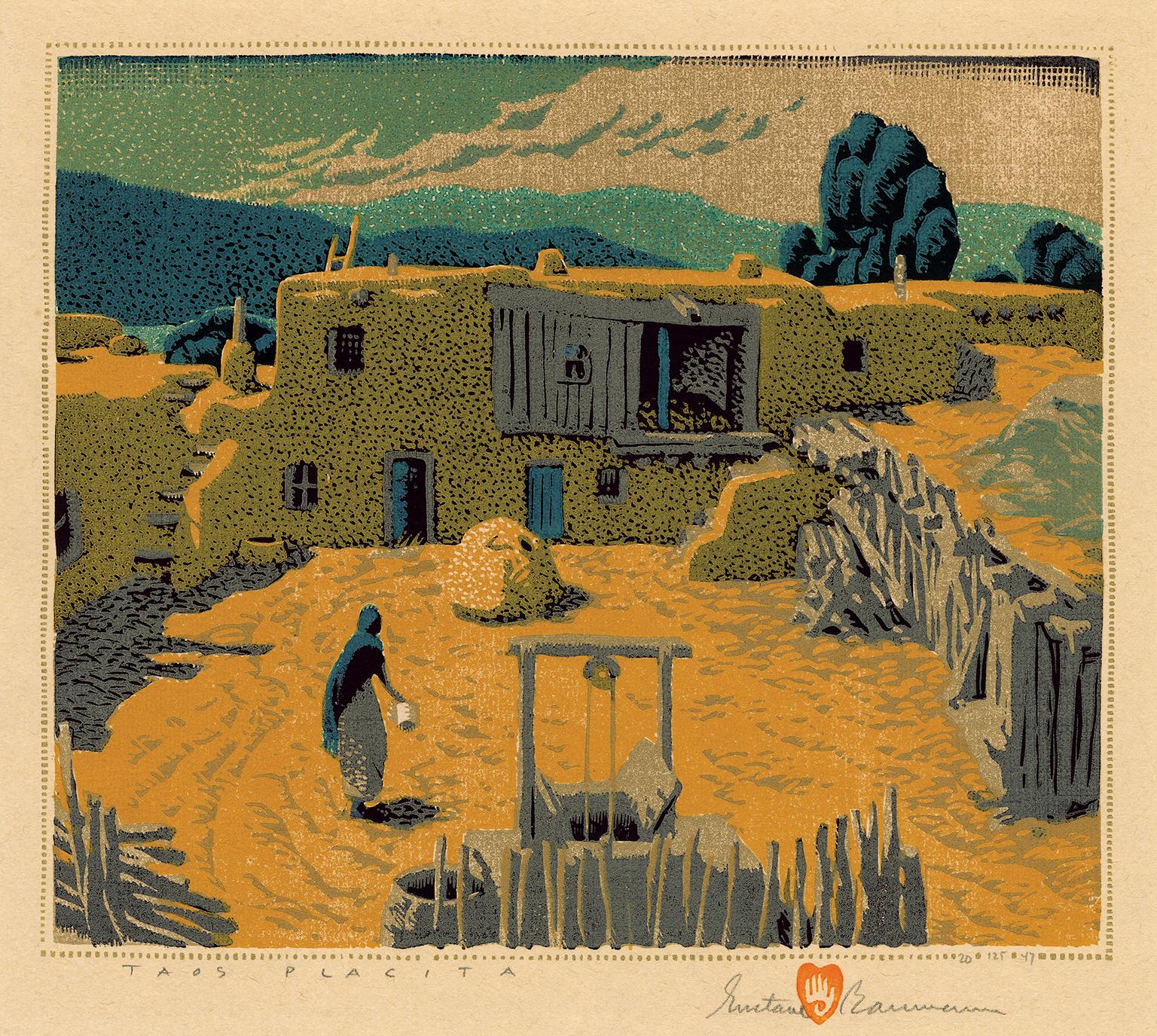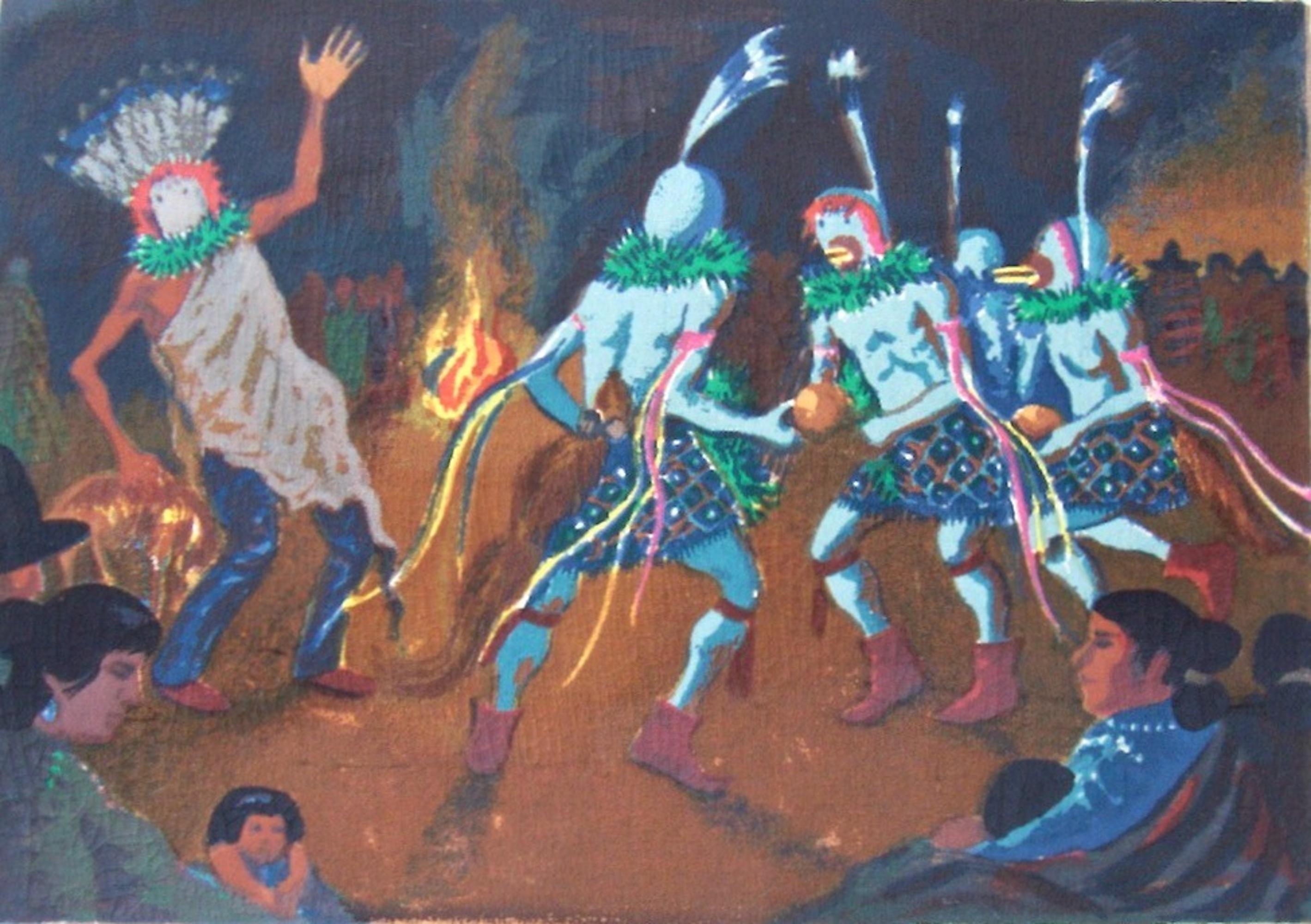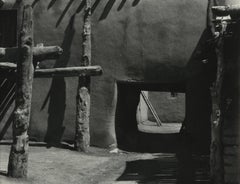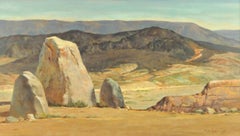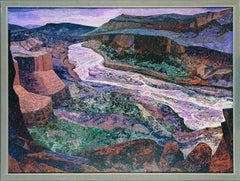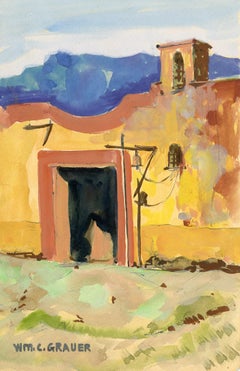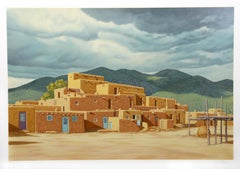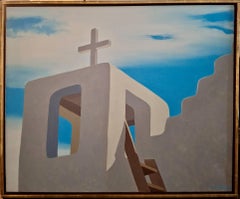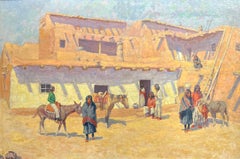Items Similar to Taos Pueblo
Want more images or videos?
Request additional images or videos from the seller
1 of 8
Anna BarryTaos Puebloc. 1945
c. 1945
$450
£341.85
€393.64
CA$643.77
A$706.15
CHF 364.14
MX$8,434.31
NOK 4,618.37
SEK 4,332.55
DKK 2,941.64
About the Item
Taos Pueblo
Screen print in colors, c. 1945
Signed and titled in pencil by the artist
Printed in Taos
Taos is the oldest continually inhabited city/village in North America.
How old is taos pueblo?
The people of Taos Pueblo have a detailed oral history which is not divulge due to religious privacy. The ancestors of the Taos people lived in this valley long before Columbus discovered America and hundreds of years before Europe emerged from the Dark Ages. Ancient ruins in the Taos Valley indicate our people lived here nearly 1000 years ago. The main part of the present buildings were most likely constructed between 1000 and 1450 A.D. The appeared much as they do today when the first Spanish explorers arrived in Northern New Mexico in 1540 and believed that the Pueblo was one of the fabled golden cities of Cibola. The two structures called Hlauuma (north house) and Hlaukwima (south house) are said to be of similar age. They are considered to be the oldest continuously inhabited communities in the USA.
How were the buildings constructed?
The Pueblo is made entirely of adobe — earth mixed with water and straw, then either poured into forms or made into sun-dried bricks. The walls are frequently several feet thick. The roofs of each of the five stories are supported by large timbers — vigas — hauled down from the mountain forests. Smaller pieces of wood — pine or aspen latillas — are placed side-by-side on top of the vigas; the whole roof is covered with packed dirt. The outside surfaces of the Pueblo are continuously maintained by replastering with think layers of mud. Interior walls are carefully coated with thin washes of white earth to keep them clean and bright. The Pueblo is actually many individual homes, built side-by-side and in layers, with common walls but no connecting doorways. In earlier days there were no doors or windows and entry was gained only from the top.
Condition: Excellent
Tape residue on reverse in the corners from previous mounting
Colrs fresh
Image size: 4-7/8 x 7-1/8"
Sheet size: 6 x 8"
Framed in a metal section frame with archival acid free matting
“In 1944, after several prior trips to the area during which they had become friends with several of the Taos Founders, Ira and his wife, the artist Anna Barry moved to Taos, New Mexico. They would reside in the area on and off until 1955. Like many others, Moskowitz was entranced by New Mexico's light, landscapes, and cultures. By the time Ira arrived there, the region had already attracted Georgia O'Keeffe, Robert Henri, and Leon Gaspard; the Southwest was starting to be recognized as an art center. Moskowitz and his wife became acquainted with Oscar Berninghaus, Andrew Dasburg, Ernest Blumenschein, and Mabel Dodge Lujan, among others. Ira wrote of that time that "Our house was always open and we had scarcely a single meal without visitors dropping in."
"Anna Barry was an artist/printmaker. She married Ira Moskowitz (from a long line of Polish rabbinical leaders) in New York in 1938. They soon visited Taos and Santa Fe in New Mexico, returning there for extended periods until in 1944 they moved there permanently—staying until 1949 when they returned to New York.
Her work in New Mexico depicts mostly the pueblos and their people, capturing ritual ceremonial dances in colorful serigraph prints and other artworks. She and Ira (also an artist) worked closely together during their New Mexico sojourns. The pueblos seemed their favored subjects there. She signed her New Mexico work as, "Anna Barry." Her prints are colorful and often detailed. The only ones I have seen (6 in all) were 5"x7" in size.
Anna probably lived longest in New York, but perhaps was also in both Europe and Israel for extended periods. (See the AskART Ira Moskowitz biography.)" Courtesy of Fred McCraw
- Creator:Anna Barry (1907 - 2001)
- Creation Year:c. 1945
- Dimensions:Height: 4.88 in (12.4 cm)Width: 7.13 in (18.12 cm)
- Medium:
- Movement & Style:
- Period:
- Condition:
- Gallery Location:Fairlawn, OH
- Reference Number:Seller: FA63101stDibs: LU14017081032
About the Seller
5.0
Recognized Seller
These prestigious sellers are industry leaders and represent the highest echelon for item quality and design.
Platinum Seller
Premium sellers with a 4.7+ rating and 24-hour response times
Established in 1978
1stDibs seller since 2013
815 sales on 1stDibs
Typical response time: <1 hour
Associations
International Fine Print Dealers Association
- ShippingRetrieving quote...Shipping from: Akron, OH
- Return Policy
Authenticity Guarantee
In the unlikely event there’s an issue with an item’s authenticity, contact us within 1 year for a full refund. DetailsMoney-Back Guarantee
If your item is not as described, is damaged in transit, or does not arrive, contact us within 7 days for a full refund. Details24-Hour Cancellation
You have a 24-hour grace period in which to reconsider your purchase, with no questions asked.Vetted Professional Sellers
Our world-class sellers must adhere to strict standards for service and quality, maintaining the integrity of our listings.Price-Match Guarantee
If you find that a seller listed the same item for a lower price elsewhere, we’ll match it.Trusted Global Delivery
Our best-in-class carrier network provides specialized shipping options worldwide, including custom delivery.More From This Seller
View AllTaos Pueblo, New Mexico (square hole)
By Edward Weston
Located in Fairlawn, OH
Taos Pueblo, New Mexico (square hole)
Gelatin silver print, 1933, printed 1953
A lifetime printing by Brett Weston, supervised by his father Edward
Edition of 5 or 6 examples
Provena...
Category
1930s American Modern Landscape Photography
Materials
Silver Gelatin
Blue Horizon (near Sante Fe, New Mexico)
By Elmer Ladislaw Novotny
Located in Fairlawn, OH
Blue Horizon (Near Sante Fe, New Mexico)
Signed by the artist lower right (see photo)
Oil on board, 16 x 27 5/8 inches
Condition: Very good. Housed in the or...
Category
1970s Realist Paintings
Materials
Oil, Board
Canyon Country
By William C. Grauer
Located in Fairlawn, OH
Acrylic on board
Signed lower right corner
Condition: Painting is excellent
Frame has surface wear
Provenance: Estate of the artist
William C. Grauer (1895-1985)
William C. Grauer (1895-1985) was born in Philadelphia to German immigrant parents. After attending the Philadelphia Museum School of Industrial Art, Grauer received a four year scholarship from the City of Philadelphia to pursue post graduate work. It was during this time that Grauer began working as a designer at the Decorative Stained Glass Co. in Philadelphia.
Following his World War I service in France, Grauer moved to Akron, Ohio where he opened a studio in 1919 with his future brother-in-law, the architect George Evans...
Category
1970s American Modern Landscape Paintings
Materials
Acrylic, ABS
untitled (Yellow Adobe Building with Bell)
By William Grauer
Located in Fairlawn, OH
Untitled (Mexican Village)
Ink and watercolor on paper, c. 1960
Estate Stamp Lower Left
Provenance: estate of the Artist
Condition: Excelleent
Image/Sheet size; 8 3/4 x 5 3/4 inches
...
Category
20th Century Landscape Drawings and Watercolors
Materials
Ink, Watercolor
Navajo Thunderbird Silversmith
By Stephen Longstreet
Located in Fairlawn, OH
Navajo Thunderbird Silversmith
Signed in ink, titled in pencil
Dimensions: 42 1/4 x 23 inches
Mixed media on paper
Provenance: Acquired from the art...
Category
Mid-20th Century American Modern Mixed Media
Materials
Mixed Media
untitled (Street Scene Mexico)
By William Grauer
Located in Fairlawn, OH
Untitled Mexican Landscape (Man Walking on Street)
Ink and watercolor on paper.
Signed with the estate stamp lower right (see photo)
From the Estate of the Artist with the artist's estate stamp lower right.
C. 1960's
Condition: excellent
Image/Sheet size: 9 7/8 x 7 5/8 inches
William C. Grauer (1895-1985)
William C. Grauer (1895-1985) was born in Philadelphia to German immigrant parents. After attending the Philadelphia Museum School of Industrial Art, Grauer received a four year scholarship from the City of Philadelphia to pursue post graduate work. It was during this time that Grauer began working as a designer at the Decorative Stained Glass Co. in Philadelphia.
Following his World War I service in France, Grauer moved to Akron, Ohio where he opened a studio in 1919 with his future brother-in-law, the architect George Evans Mitchell. Soon, the Rorimer-Brooks design company, the developer Van Swerngen brothers, as well as the Sterling Welch and Halle Bros. department stores realized the extent of Grauer's talent and eagerly employed him. Grauer’s work during this time included architectural renderings for Shaker Square, Moreland Courts, and other many other projects commissioned by Cleveland architects. Grauer also remained true to his roots as a master designer of stained glass windows. With his work in such high demand, Grauer received a commission in 1921 to paint murals for the French Grill...
Category
1960s American Modern Landscape Drawings and Watercolors
Materials
Watercolor
$500 Sale Price
28% Off
You May Also Like
Pueblo, American Realist Screenprint by Lorna Patrick
Located in Long Island City, NY
Lorna Patrick, American - Pueblo, Year: 1981, Medium: Screenprint, signed and numbered in pencil, Edition: 295, Size: 31 x 42 in. (78.74 x 106.68 cm), Description: Set beneath...
Category
1980s American Realist Landscape Prints
Materials
Screen
“Adobe Wall Taos Pueblo”
Located in San Francisco, CA
In perfect simplicity, the essence of timeless Taos comes together in this picture. Start with the cerulean sky and particularly notice the light on the structure, a magnet to painte...
Category
1980s American Modern Landscape Paintings
Materials
Canvas, Oil
Moonlight on Taos Pueblo
By Nathan Solano
Located in Colorado Springs, CO
Original painting signed by the Artist on lower left.
Category
21st Century and Contemporary Realist Paintings
Materials
Oil
Mid-day, Zuni Village
By Frank Reed Whiteside
Located in Missouri, MO
Mid-day, Zuni Village, 1897
By. Frank Reed Whiteside (American, 1866-1929)
Unframed: 20" x 30"
Framed: 28" x 38"
Frank Reed Whiteside, born in Philadelphia on 20 August 1867, became a student of Thomas Anshutz at the Pennsylvania Academy of the Fine Arts (1888-92). He already began exhibiting there during his student years (1887-98). In 1893, he enrolled in the Académie Julian in Paris where he received instruction from Jean-Paul Laurens and Benjamin Constant. After his French academic training, Whiteside taught art in Philadelphia high schools. He took frequent trips to the Southwest between 1890 and 1928 to live with and paint the Zuni Indians. Whiteside depicted ceremonial dances, Zuni buildings, and other genre scenes, usually in blinding afternoon sunlight. He carefully observed the effects of light on vibrant color, using a finely crafted impressionist technique. He was fond of broad areas of color, subtle combinations of hues, and simplified shapes and silhouettes. Whiteside continued to exhibit at the PAFA (1905-15), at the Art Institute of Chicago (1896-1916), at the Carnegie International (1905 and 1907) and at the Corcoran Gallery (1907). He was a member of Philadelphia art societies and beginning in 1909 had a summer studio in Ogunquit, Maine, where he took part in Hamilton Easter Field's discussion groups. Frank's wife, Clara Walker Whiteside, who published Touring New England in 1926, was active in the Ogunquit Art Association.
Like Stanford White, Frank Reed Whiteside was the victim of murder, on 19 September 1929, but Whiteside's case remains unsolved. One night, the sixty-three year-old painter answered the doorbell. Two witnesses...
Category
Late 19th Century Other Art Style Figurative Paintings
Materials
Canvas, Oil
Price Upon Request
'Taos Placita' — American Southwest Regionalist Masterwork
By Gustave Baumann
Located in Myrtle Beach, SC
Gustave Baumann, 'Taos Placita', color woodcut, 1947, edition 125. Baumann 132. Signed, titled, and numbered '20-125' in pencil; with the artist’s Hand-in-Heart chop. A superb, richly-inked impression, with fresh colors, on fibrous oatmeal wove paper; the full sheet with margins (2 to 3 1/8 inches); slight rippling at the left sheet edge, in excellent condition. Matted to museum standards, unframed.
Image size 9 5/8 x 11 1/4 inches (244 x 286 mm); sheet size 13 1/4 x 17 inches (337 x 432 mm).
Collections: Harwood Museum of Art, New Mexico Museum of Art, Phoenix Art Museum, Scottsdale Art Museum, Wichita Art Museum.
ABOUT THE ARTIST
Gustave Baumann (1881-1971) was a renowned printmaker and a leading figure of the American color woodcut revival whose exquisite craftsmanship and vibrant imagery captured the essence of the Southwest.
"A brilliant printmaker, Baumann brought to the medium a full mastery of the craft of woodworking that he acquired from his father, a German cabinetmaker. This craftsmanship was coupled with a strong artistic training that resulted in the handsome objects we see in the exhibition today. After discovering New Mexico in 1918, Baumann began to explore in his woodblock prints of this period the light. color, and architectural forms of that landscape. His prints of this period are among the most beautiful and poetic images of the American West."
—Lewis I. Sharp, Director, Denver Art Museum
Baumann, the son of a craftsman, immigrated to the United States from Germany with his family when he was ten, settling in Chicago. From 1897 to 1904, he studied in the evenings at the Art Institute of Chicago, working in a commercial printmaking shop during the day. In 1905, he returned to Germany to attend the Kunstwerbe Schule in Munich, where he decided on a career in printmaking. He returned to Chicago in 1906 and worked for a few years as a graphic designer of labels.
Baumann made his first prints in 1909 and exhibited them at the Art Institute of Chicago the following year. In 1910, he moved to the artists’ colony in Nashville, Indiana, where he explored the creative and commercial possibilities of a career as a printmaker. In 1915, he exhibited his color woodcuts at the Panama-Pacific International Exposition in San Francisco, winning the gold medal.
Among Baumann’s ongoing commercial activities was his work for the Packard Motor Car Company from 1914 to 1920 where he produced designs, illustrations, and color woodcuts until 1923.
In 1919, Baumann’s printmaking work dominated the important exhibition of American color woodcuts at the Detroit Institute of Arts. Twenty-six of his prints were included, far more than the works of any other artist. A set of his blocks, a preparatory drawing, and seven progressive proofs complemented the exhibition. That same year, Baumann worked in New York and, over the summer, in Provincetown, Massachusetts. His airy images of Cape Cod employed soft, pastel colors and occasionally showed the influence of the white-line woodcut technique.
Many of his Chicago artist friends had traveled to the southwest, and Baumann became intrigued by their paintings, souvenirs, and stories of an exotic place named Taos, New Mexico. In the summer of 1918, he spent the summer in Taos sketching and painting before visiting Santa Fe. Paul Walter, the director of the Museum of New Mexico, offered him a studio in the museum's basement. Inspired by the rugged beauty of the Southwest—the vibrant colors and dramatic landscapes of the region became a central theme in his work, influencing his artistic style and subject matter for the remainder of his career. Later in the decade, he traveled to the West Coast and made prints of California landscape.
Baumann's prints became synonymous with the Southwest, capturing the spirit of its place in America's identity with a unique sense of authenticity and reverence. His iconic images of desert vistas, pueblo villages, and indigenous cultures served as visual tributes to the region's rich cultural heritage, earning him a dedicated following among collectors and curators alike.
A true craftsman and artist, Baumann completed every step of the printmaking process himself, cutting each block, mixing the inks, and printing every impression on the handmade paper he selected. His dedication to true craftsmanship and his commitment to preserving the integrity of his artistic vision earned him widespread acclaim and recognition within the art world. About the vibrant colors he produced, Baumann stated, “A knowledge of color needs to be acquired since they don’t all behave the same way when ground or mixed...careful chemistry goes into the making of colors, with meticulous testing for permanence. While complicated formulae evolve new colors, those derived from Earth and metal bases are still the most reliable.”
In the 1930s, Baumann became interested in puppet theater. He designed and carved his own marionettes and established a little traveling company. From 1943 to 1945, the artist carved an altarpiece for the Episcopal Church of the Holy Faith in Santa Fe. In 1952, a retrospective exhibition of his prints was mounted at the New Mexico Museum of Fine Arts. Throughout his prolific career, Baumann executed nearly four hundred color woodcuts.
Baumann’s woodcuts...
Category
1940s American Modern Landscape Prints
Materials
Woodcut
Anna Barry, Navajo Yei Bei Chai
By Anna Barry
Located in New York, NY
Anna Barry (1907-2001), and her husband, the artist Ira Moskovitz, spent years in New Mexico in the late 1930s and 40s. They returned permanently to New York City in 1949.
The screen print (also known as silk screen or serigraph) Navajo Yei...
Category
Mid-20th Century American Modern Figurative Prints
Materials
Screen
